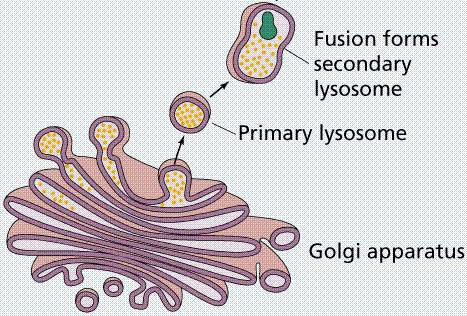Lysosome, membrane-bound sac found in nucleated
cells that contains digestive enzymes that break down
complex molecules in the body. Lysosomes are
numerous in disease-fighting cells, such as white blood
cells, that destroy harmful invaders or cell debris.
Lysosomes vary greatly in size, typically ranging from
0.05 to 0.5 micrometers in diameter. Each lysosome is
surrounded by a membrane that protects the cell from
the lysosome's digestive enzymes—if the lysosome
breaks open, the enzymes would destroy the cell.
Proteins embeded in the lysosome membrane protect
the activity of the enzymes by maintaining the proper
internal acidity. Membrane proteins also transport
digested products out of the lysosome.
Lysosome enzymes are manufactured in the rough
endoplasmic reticulum and processed in the Golgi
apparatus. They are delivered by sacs known as
transport vesicles to fuse with three types of
membrane-bound structures: endosomes, phagosomes,
and autophagosomes. Endosomes form when the cell
membrane surrounds nutritional molecules like
polysaccharides, complex lipids, nucleic acids, or
proteins. In a process called endocytosis, these
molecules are broken down for reuse. Phagosomes form
when the cell membrane engulfs large objects, like
debris from sites of injury or inflammation or
disease-causing bacteria, in a process called
phagocytosis. Autophagosomes form when the
endoplasmic reticulum wraps around spent cell
structures, such as mitochondria, that are destined for
recycling. In all cases the digestive enzymes supplied
by the lysosomes digest the membrane-bound objects
into simple compounds that are delivered to the
cytoplasm as new cell-building materials.
Lysosome enzyme disorders can cause disease. Infants
born with Tay-Sachs disease lack an enzyme that
breaks down a complex lipid called ganglioside. When
this lipid accumulates in the body, it damages the
central nervous system, causes mental retardation,
and results in death by age five. The inflammation and
pain associated with rheumatoid arthritis and gout are
related to the escape of lysosome enzymes.
Some scientists classify plant vacuoles as a type of
lysosome. These membrane-bound structures are much
larger than other lysosomes, measuring up to 20
micrometers in diameter. Vacuoles maintain water
pressure within plant cells, called turgor, preventing
wilting. Vacuoles may also provide long-term storage of
polysaccharides, lipids, proteins, pigments, and harmful
materials such as rubber or opium that may deter
predators.
Contributed By: John B. Ferguson, Sc.B., M.Phil., Ph.D.
Professor of Biology, Division of Natural Sciences and
Mathematics, Bard College. Director, Distinguished
Scientist Lecture Series, Bard Center.
Bio
|
